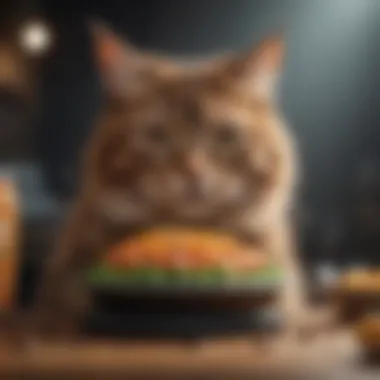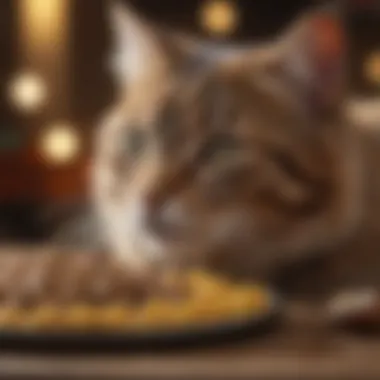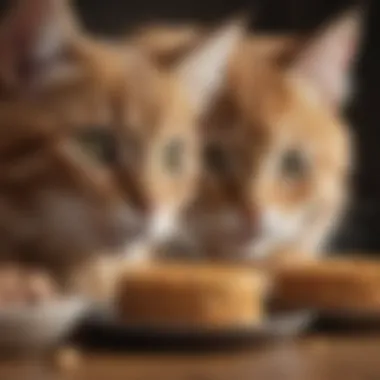Unveiling the Ultimate All Ages Cat Food Selection Guide for Optimal Feline Nutrition


Animal Species Profile
When it comes to understanding the dietary needs of different cat age groups, a deep dive into the world of feline nutrition becomes imperative. From the early stages of kittenhood to the senior years of a cat's life, the type of food they consume plays a crucial role in their overall health and well-being. This article aims to provide a comprehensive guide to selecting the best all ages cat food, ensuring that cats of all life stages receive the necessary nutrients for optimal growth and maintenance.
Choosing the Right Food
Selecting the appropriate cat food involves considering various factors, such as a cat's age, activity level, and any specific health concerns they may have. For kittens, a diet that supports growth and development is crucial, while adult cats require a balance of nutrients to maintain their overall health. Senior cats, on the other hand, benefit from foods that support joint health and cognitive function as they age. By understanding the nutritional needs of cats at different life stages, pet owners can make informed choices that cater to their feline companions' individual requirements.
To optimize a cat's diet, pet owners should look for specific ingredients that offer essential nutrients. High-quality protein sources, such as poultry, fish, and meat by-products, are vital for cats' muscle development and overall well-being. Additionally, incorporating omega-3 fatty acids, taurine, and vitamins like A and E can support healthy skin, coat, and immune function in cats of all ages. By prioritizing ingredients that meet feline nutritional needs, pet owners can ensure that their cats receive a well-rounded diet that promotes vitality and longevity.
Ensuring Optimal Nutrition
In the quest for the best all ages cat food choices, pet owners must also be mindful of key nutritional considerations. Ensuring that the selected food meets or exceeds the nutritional standards set by organizations like the Association of American Feed Control Officials (AAFCO) is essential. By choosing cat foods that are labeled as complete and balanced, pet owners can rest assured that their feline friends are receiving all the necessary nutrients for a healthy diet.
Moreover, understanding the role of hydration in cats' health is paramount. Since cats have a low thirst drive compared to other animals, ensuring they consume an adequate amount of water is vital. Wet cat food can be a valuable addition to a cat's diet, as it provides moisture along with essential nutrients. By offering a varied diet that includes both dry and wet food options, pet owners can promote hydration and overall health in their feline companions.
Catering to Individual Needs
As each cat is unique, considering individual preferences and dietary sensitivities is key to providing optimal nutrition. Some cats may have specific allergies or intolerances that require specialized diets, such as grain-free or limited ingredient options. By observing how a cat responds to different foods and being attentive to any signs of digestive upset or skin issues, pet owners can tailor their cat's diet to suit their specific needs.
Understanding Feline Nutrition
Nutritional Needs of Cats
Protein Requirements
When delving into the realm of feline nutrition, the significance of Protein Requirements cannot be overstated. Proteins serve as the building blocks of a cat's body, essential for muscle growth, repair, and overall development. High-quality protein sources contribute to a cat's lean muscle mass, strength, and energy levels. By prioritizing protein-rich foods, we ensure our feline friends receive the necessary amino acids to thrive. However, excessive protein intake may pose risks such as kidney strain, emphasizing the importance of a balanced approach.
Essential Nutrients


Essential Nutrients form the bedrock of a cat's diet, encompassing vitamins, minerals, and other vital components. These nutrients play a pivotal role in maintaining various bodily functions, from supporting vision and cardiac health to promoting a lustrous coat. Ensuring adequate intake of essential nutrients is paramount for preventing deficiencies and fostering optimal well-being in cats. However, it is crucial to strike a balance in nutrient proportions to prevent potential health issues.
Caloric Intake
Caloric Intake stands as a crucial factor in feline nutrition, as it directly impacts a cat's energy levels and body weight. Determining the right caloric intake for a cat involves considering factors such as age, activity level, and metabolic rate. Understanding the caloric requirements of our feline companions helps prevent obesity or malnutrition. Balancing caloric intake with energy expenditure is key to maintaining a healthy weight and promoting overall feline wellness.
Factors Influencing Cat Food Choice
Life Stage
One of the primary factors influencing cat food choice is the cat's life stage, be it kitten, adult, or senior. Each life stage necessitates specific nutritional requirements to support growth, maintenance, or age-related health concerns. Tailoring the cat's diet to its life stage ensures it receives the appropriate nutrients and calories for optimal health. However, transitioning between life stages requires a gradual adjustment to prevent digestive issues and nutrient imbalances.
Health Conditions
Health Conditions play a pivotal role in determining the suitable diet for a cat, especially if it has specific medical needs or chronic conditions. Addressing these health concerns through specialized diets can contribute to improved quality of life and manage underlying issues effectively. Selecting cat food that caters to specific health conditions requires consultation with a veterinarian to ensure the dietary requirements align with the cat's well-being.
Activity Levels
Cat food choice should also align with the cat's activity levels, whether it is a playful, active feline or a more sedentary companion. Active cats may require higher-protein or high-energy diets to fuel their energetic lifestyle, while less active cats benefit from controlled caloric intake to prevent weight gain. Tailoring the cat's diet to its activity levels optimizes nutrition and supports its overall health and vitality.
Avoiding Harmful Additives
Artificial Preservatives
Artificial preservatives, commonly used in commercial pet foods, play a controversial role in feline nutrition. While these additives extend the shelf life of cat food, their long-term effects on cat health have raised concerns among pet owners and veterinarians. Artificial preservatives, such as BHA and BHT, have been linked to potential health risks, including allergies and adverse reactions in some cats. Opting for cat food with natural preservatives like tocopherols or ascorbic acid can mitigate these risks and offer a safer alternative for feline nutrition.
Fillers and By-Products
Fillers and by-products in cat food often serve as inexpensive sources of nutrients but may lack the essential quality and digestibility required for feline health. Fillers, such as corn or wheat gluten, provide limited nutritional value and may contribute to digestive issues or food sensitivities in cats. Similarly, by-products derived from animal processing can vary in quality and may contain parts unfit for human consumption. Pet owners seeking high-quality cat food should prioritize whole meat sources and nutrient-dense ingredients over fillers and by-products to ensure premium nutrition and optimal health for their cats.
Excessive Salt and Sugar


Salt and sugar, when present in excessive amounts in cat food, can pose significant health risks for felines. High sodium levels in cat diets can lead to dehydration, kidney strain, and cardiovascular issues over time. Similarly, an abundance of sugar or sweeteners in cat food can contribute to obesity, dental problems, and fluctuating blood sugar levels in cats. Pet owners must scrutinize the ingredient list of cat food to avoid products with added salt or sugar, prioritizing natural flavors and nutrient-dense options for their feline companions' long-term health and well-being.
Recommended Brands and Products
When it comes to selecting the best all ages cat food, the choice of brands and products plays a vital role in ensuring optimal nutrition and well-being for your feline companion. Quality brands offer a range of options tailored to different life stages and health requirements, making it easier to find the perfect match for your cat. Considerations such as ingredients, reputation, and nutritional value should guide your decision to provide your cat with the best possible diet.
Top Picks for Kittens
Brand A Kitten Formula
Brand A Kitten Formula stands out for its emphasis on high-quality protein sources and essential nutrients crucial for the healthy growth and development of kittens. With a focus on digestible carbohydrates, this formula ensures easy digestion and absorption of vital nutrients. Its carefully balanced ingredients make it a popular choice among cat owners looking to provide their kittens with a wholesome diet.
Brand B Young Cat Blend
Brand B Young Cat Blend excels in incorporating essential fatty acids that support overall feline health and well-being. The key characteristic of this blend lies in its promotion of healthy skin, coat, and immune system. While its unique feature lies in its blend of antioxidants, cat owners can be assured of added protection against oxidative stress and aging. Choosing this blend offers multiple benefits for young cats, making it an attractive option.
Best Options for Adult Cats
Brand All Life Stages Recipe
Brand X All Life Stages Recipe caters to the diverse needs of adult cats by offering a comprehensive blend of essential nutrients suitable for all life stages. Its key characteristic lies in its adaptability, ensuring that cats of varying ages and requirements receive adequate nutrition. With a focus on balanced nutrition and digestibility, this recipe is a popular choice for cat owners seeking a versatile and beneficial option.
Brand Y Mature Cat Formula
Brand Y Mature Cat Formula is specifically crafted to address the nutritional needs of mature cats, focusing on factors such as joint health, immunity, and digestion. Its key characteristic is its holistic approach to senior cat nutrition, offering targeted support for common age-related issues. The unique feature of this formula is its inclusion of probiotics, aiding in digestive health and nutrient absorption. Cat owners looking to provide tailored nutrition for their aging feline companions often opt for this formula.
Specialized Senior Cat Foods
Brand Z Senior Wellness Blend


Brand Z Senior Wellness Blend is renowned for its emphasis on overall wellness and vitality for senior cats. The key characteristic of this blend is its incorporation of joint-supporting ingredients, promoting mobility and comfort in aging cats. Its unique feature lies in the inclusion of cognitive health supplements, addressing cognitive function in senior felines. Choosing this blend offers comprehensive care and targeted support for senior cats, making it a prudent choice for cat owners focusing on their elder pet's well-being.
Brand Senior Care Formula
Brand C Senior Care Formula prioritizes individualized care for senior cats, focusing on specific health concerns and dietary requirements. Its key characteristic is its personalized approach, tailoring nutrients to support immune function and organ health in aging felines. The unique feature of this formula is its inclusion of specialized supplements for common age-related issues, offering a holistic solution for senior cat care. Cat owners seeking a customized and dedicated approach to senior cat nutrition often opt for this formula.
Feeding Guidelines and Tips
Feeding guidelines and tips play a crucial role in ensuring the health and well-being of our feline companions. When it comes to selecting the best all ages cat food, understanding how to feed our cats properly is essential. Proper feeding guidelines can impact everything from a cat's energy levels to its overall health and longevity. By following expert advice on feeding, cat owners can optimize their pet's nutrition for every stage of life.
Portion Control and Meal Frequency
Balancing food intake is a critical aspect of cat care. Cats have specific dietary needs based on their age, size, and activity level. Understanding the right portion sizes and meal frequencies can prevent overeating and obesity. It is advisable to follow feeding guidelines provided by veterinarians or pet nutritionists to ensure the cat receives the necessary nutrients without excess calories. Proper portion control also helps in managing any existing health conditions in cats.
Feeding Schedule Suggestions
Establishing a consistent feeding schedule is important for cats. Cats thrive on routine, and having set mealtimes can help prevent digestive issues and maintain a healthy appetite. Providing meals at the same time each day helps regulate metabolism and digestion. It is recommended to feed adult cats at least twice a day, while kittens may require more frequent feedings. Feeding schedules should align with the cat's natural instincts, promoting regular bowel movements and reducing the risk of gastrointestinal problems.
Monitoring Weight and Condition
Regularly monitoring a cat's weight and condition is essential for identifying potential health issues early on. Maintaining a healthy weight is crucial for a cat's overall well-being. Sudden weight gain or loss can indicate underlying health problems or improper diet. By observing changes in weight, fur quality, and activity levels, cat owners can detect any abnormalities and seek veterinary advice promptly. Tracking a cat's body condition score can also help in adjusting portion sizes and meal frequencies accordingly.
Transitioning to New Food
When transitioning to a new food, the gradual transition method is recommended to prevent digestive upset. Abrupt changes in diet can lead to gastrointestinal disturbances in cats. Slowly introducing the new food by mixing it with the old one over a period of 7-10 days allows the cat's digestive system to adapt. This method minimizes the risk of dietary intolerance and helps the cat adjust to the new food's taste and texture.
Observing Digestive Changes
During the transition period, closely observing any digestive changes in the cat is crucial. Common signs of digestive issues include vomiting, diarrhea, lethargy, or changes in appetite. Monitoring the cat's stool consistency and frequency can provide insights into how well the cat is tolerating the new food. Any persistent digestive issues should be reported to a veterinarian for further evaluation and recommendations.
Consulting with a Veterinarian
Importance of Veterinary Input
Individual Health Considerations
Delving into the realm of Individual Health Considerations is a pivotal aspect of consulting with a veterinarian. These considerations focus on the unique health needs of each cat, taking into account factors like breed, age, weight, and any existing medical conditions. By addressing individual health considerations, veterinarians can provide tailored advice on nutrition and dietary requirements, ensuring that your cat receives customized care for optimal health and well-being. This personalized approach acknowledges that every cat is different and may have specific health concerns that necessitate individualized attention.







